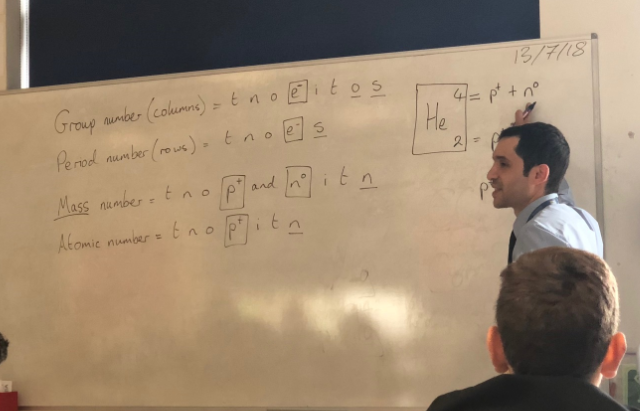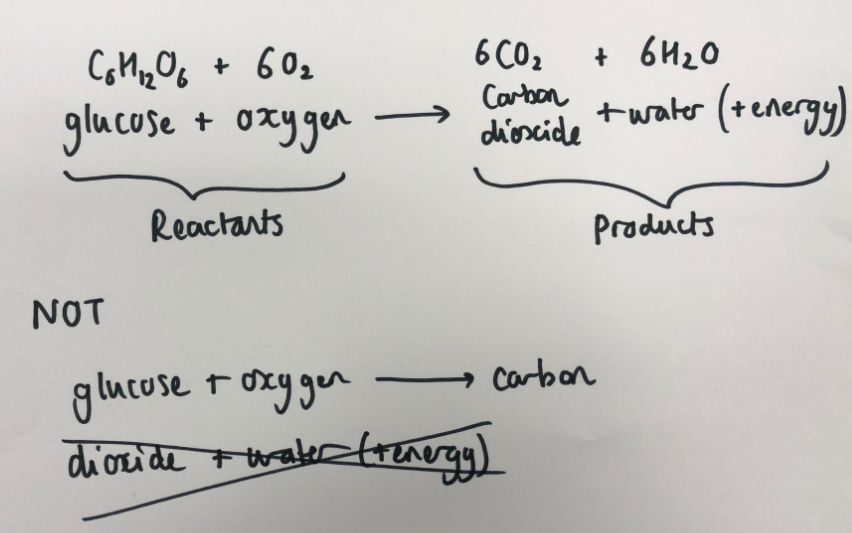My first impression of Mr Gabr’s start to the lesson can be summarised into three words: purposeful, warm and knowledge-rich.
Image: Mr Gabr teaching. This is from a different lesson. Not the lesson mentioned in the blog.
Mr Gabr’s million dollar smile greets children whilst he stands at the threshold of the Classroom. This is a Teach Like a Champion (TLACI) technique referred to as ‘Threshold’. One foot in the corridor to keep track of children walking towards the teacher. One foot in the classroom to ensure that pupils know that when they enter the room they are to be silent and start the work prepared on the whiteboard. Mr Gabr’s eyes are everywhere!
The first child enters the classroom, mirroring Mr Gabr’s smile. The pupil walks to his desk and starts thinking about the questions displayed on the board. This pupil silently recites the two definitions written on the board. Another two pupils enter and do the same. Every second counts and Mr Gabr is quick to start firing questions to individual pupils whilst they are organising their books and getting their equipment out, straight into a SLANT position, tracking Mr Gabr.
Mr Gabr asks one pupil a question which he answers incorrectly. Mr Gabr poses the same question to another pupil. The second pupil asked says the right answer, Mr Gabr then asks the first pupil to repeat the answer. The first pupil starts smiling, Mr Gabr reads his mind “See you did know the answer, you just spaced for a minute, happens to me too.” This is a lovely and slick demonstration of TLAC’s teaching technique referred to as “No opt out.”
All pupils have now entered the room, at their desk, book and equipment out, Mr Gabr tells all pupils to take a seat. He informs pupils to get writing into their books to answer the questions on the whiteboard. Great demonstration of TLAC’s ‘Do Now’, a speedy review for 5 minutes. Pupils are in a solid routine and start the work without any direction from Mr Gabr. To help pupils Mr Gabr reads out the question, asks for whole class choral response after 3 for the answer to the question.
Mr Gabr: “What is the definition of a prokaryotic cell? 3 – 2 – 1″
Whole class: “A cell with no membrane-bound organelles.”
Mr Gabr: “Give me an example of what I mean by ‘no membrane-bound organelles’? 3 – 2 – 1″
Whole class: “No nuclei”
Mr Gabr: “What is the definition of a eukaryotic cell? 3 – 2 – 1″
Whole class: “A cell with Membrane-bound organelles.”
Mr Gabr: “Give me an example of what I mean by ‘membrane-bound organelles’? 3 – 2 – 1″
Whole class: “Cells with nuclei”
Mr Gabr: “Now only the boys!”
Boys only: “Cells with nuclei”
Kids have finished writing. Pupils are asked to SLANT and track the teacher. Mr Gabr poses his next series of questions. A pupil responds with a mediocre answer where he used the term ‘egg’ instead of ‘ovum’. This is another learning opportunity for the kids. Mr Gabr then poses the questions “What is the scientific word for ‘egg’?”
There is a forest of hands up in the air. At Charter, we push to have as many pupils to have their hands up in the air to answer questions. The pupil who gave the mediocre response is asked to repeat his answer using the word ‘ovum’ rather than the word ‘egg’.
It’s been 10 minutes of teaching where every second has really mattered. He introduces what will be taught today and dives straight into looking at respiration’s chemical equation. He is very deliberate with wording, and he pre-empts possible misconceptions that pupils may have in advance. For example, he states that in a chemical equation we use an arrow to separate the reactants from the products, not an equal sign. Pre-empting that ‘equation’ is a term used in maths which refers to an equal sign or identity sign being present. He pre-empts that reactants of a chemical equation are on the left hand side of the arrow, and that products are on the right hand side of the arrow. He talks about how when we write carbon dioxide as one of the products in the chemical equation, we write dioxide right below carbon, we don’t go to the left of the margin to start a new line, as it may look like you wrote dioxide to be a reactant.
Image: Recreation of Mr Gabr’s board work
He explains that we write energy as a product but the term ‘+ energy’ must be in brackets, because energy is not matter. Chemical reactions do involve energy. He emphasised the importance of this and showed pupils how to write the equation with energy as a product, and the incorrect way of writing the equation with energy as a product.
I’ve only witnessed the first fifteen minutes of Mr Gabr’s lesson, but here is a summary of what I’ve witnessed to be great classroom practice from an experienced teacher:
- Warm welcome to the classroom
- Use of TLAC teaching techniques: “Threshold” “I say, you say” “No opt out” “Slant” “Do Now”
- Whole class choral response: all pupils are expected to participate, if they don’t know the answer then they are able to learn it from others around them
- Purposeful start to the lesson: task is prepared
- Improving pupil answers from mediocre answers to top quality answers
- Pre-empting misconceptions
- Precise and Concise teacher instruction
At Great Yarmouth Charter Academy, we have an open door policy where teachers are welcomed to observe and learn from their colleagues. This invitation to visit extends to local members of the community, parents, teachers and Headteachers far and wide. We have had several visitors come and experience a day with us. This is also an invitation welcoming you to visit our school. Please feel free to get in touch with the school office to arrange a tour.
If you wish to know more about our school feel free to check out the blogs and tweets of our staff:
Head Teacher: Mr Barry Smith (@BarryNSmith79)
Assistant Principal: Dr Anthony Radice (@AnthonyRadice1)
Assistant Principal: Mr Darren Hollingsworth (@DarrenHolly3J)


Leave a Reply
You must be logged in to post a comment.